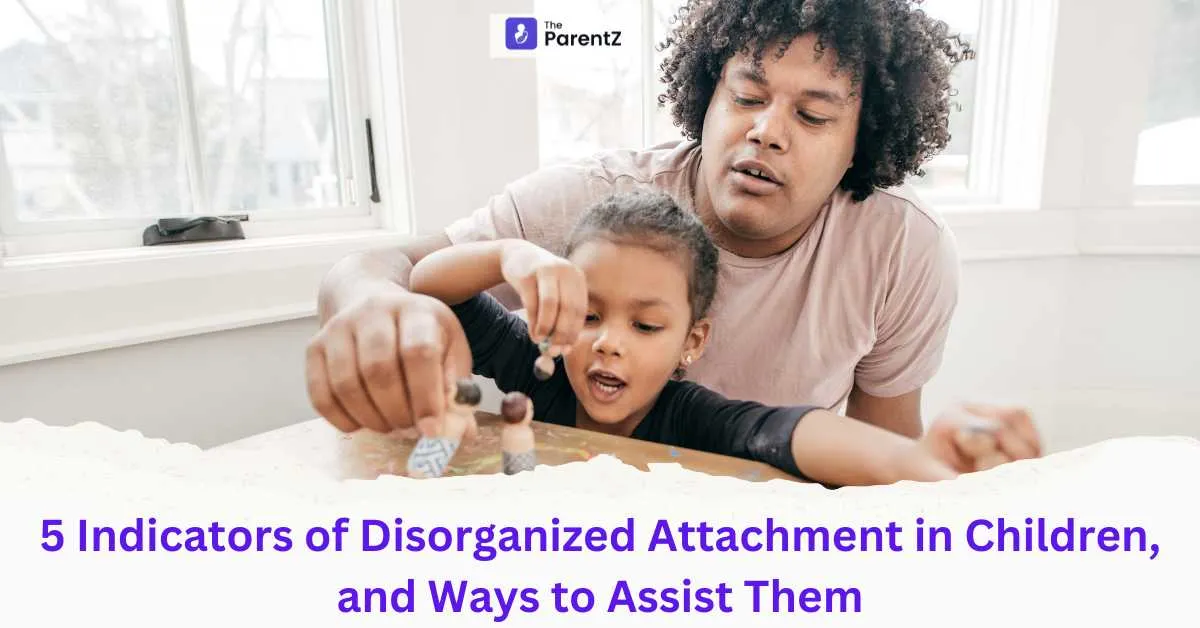Introduction: Understanding the Complexity of Attachment
Attachment styles play a critical role in shaping how children perceive safety, love, and relationships. While secure attachment is often seen as the ideal, not all children develop it. One of the more challenging forms of insecure attachment is disorganized attachment. In this style, children exhibit contradictory or confusing behaviors toward their primary caregivers, reflecting both a desire for closeness and a deep sense of fear or mistrust.
This article provides a systematic look at five key indicators of disorganized attachment in children and offers detailed strategies on how parents and caregivers can help. By recognizing these signs early and responding with consistency and compassion, it is possible to nurture healthier emotional development over time.
What is Disorganized Attachment?
Disorganized attachment arises when a child’s early experiences with caregivers involve unpredictability, inconsistency, or fear. Unlike secure attachment—where a child feels protected and comforted—children with disorganized attachment often find their caregivers both soothing and threatening. This internal conflict leads to confusion, anxiety, and disoriented behaviors.
Several factors can contribute to disorganized attachment:
- Trauma or neglect: Children who experience emotional, physical, or psychological harm may struggle to form a coherent attachment strategy.
- Inconsistent caregiving: When a caregiver’s responses swing between attentive and rejecting, the child cannot predict how they will be treated.
- Caregiver mental health issues: Parents struggling with depression, anxiety, or unresolved trauma may unintentionally transmit fear or unpredictability to their children.
Research by developmental psychologists such as Mary Main and Judith Solomon has highlighted how disorganized attachment can affect a child’s emotional regulation, stress responses, and future relationships. Although it may seem daunting, early intervention and supportive caregiving can significantly improve outcomes.
5 Indicators of Disorganized Attachment
1. Contradictory or Confusing Behavior Toward Caregivers
Description:
Children with disorganized attachment often display inconsistent reactions to their caregivers. They may:
- Rush to hug a parent but abruptly pull away without explanation.
- Cry for comfort, yet freeze or become distressed when the caregiver approaches.
- Alternate between clinging and rejecting behavior within short time spans.
Why It Happens?
This contradiction stems from internal conflict. The child seeks safety and reassurance from the caregiver but also feels fear or uncertainty due to past negative experiences. As a result, the child does not develop a clear strategy for interacting with the caregiver.
How to Help?
- Consistent Responses: Respond calmly and predictably to the child’s emotional cues. Over time, steady, reliable reactions can help reduce the child’s confusion.
- Give Emotional Space: If the child resists comfort, do not force it. Offer support in a gentle, non-intrusive way, allowing them to approach at their own pace.
- Maintain a Warm Tone: Use reassuring language and maintain a calm demeanor. This consistency can gradually build trust.
2. Extreme Difficulty Regulating Emotions
Description:
Children with disorganized attachment often have significant struggles with emotional regulation. Signs may include:
- Sudden mood swings without clear triggers.
- Prolonged or intense tantrums that are hard to soothe.
- Difficulty calming down after minor upsets.
Why It Happens?
Inconsistent or frightening caregiving experiences can disrupt a child’s ability to develop healthy coping mechanisms. Their stress response system remains on high alert, making it challenging for them to manage strong emotions.
How to Help?
- Model Calm Behavior: Children learn emotional regulation by observing adults. Show how to handle frustration in a healthy manner (e.g., taking a deep breath, speaking calmly).
- Teach Soothing Techniques: Techniques such as deep breathing, quiet reading corners, or listening to calming music can help the child self-regulate.
- Validate Feelings: Acknowledge the child’s emotions, even if they seem disproportionate. This helps them feel understood and reduces the fear of expressing emotions.
3. Fear of Authority or Defiance
Description:
Children with disorganized attachment may display polarized responses to authority figures:
- Some may comply in an almost fearful, rigid manner.
- Others may exhibit strong defiance, aggression, or resistance to rules and structure.
Why It Happens?
When a caregiver’s reactions have been unpredictable or harsh, children may develop mistrust toward authority. They might fear punishment and comply out of anxiety, or rebel to protect themselves from perceived threats.
How to Help?
- Set Clear, Fair Boundaries: Consistency in rules and consequences helps children understand what to expect.
- Use Positive Reinforcement: Praise and rewards for good behavior are generally more effective than fear-based discipline.
- Offer Choices: Providing limited, age-appropriate choices (e.g., “Would you like to do your homework now or after a snack?”) gives a sense of control and reduces power struggles.
4. Difficulty Forming Friendships or Trusting Others
Description:
Children with disorganized attachment may find it hard to build or maintain healthy relationships with peers. Signs include:
- Avoiding close friendships or intimate connections.
- Clinging too strongly to certain people while remaining distant from others.
- Struggling with empathy or reading social cues.
Why It Happens?
Early attachment experiences shape how a child views all future relationships. If a child’s primary attachment figures were unreliable or frightening, they may generalize this mistrust to peers and teachers, fearing rejection or betrayal.
How to Help?
- Encourage Gradual Social Interaction: Start with small, manageable playdates or group activities to build confidence.
- Teach Empathy and Social Skills: Discuss emotions and relationships through storytelling, role-playing, or reading books about friendship.
- Offer a Secure Base: Remind the child that you are available for support, even when they are interacting with others. This reassurance can reduce social anxiety.
5. Signs of Anxiety, Hypervigilance, or PTSD-Like Symptoms
Description:
Some children with disorganized attachment show signs resembling chronic stress or trauma, such as:
- Excessive vigilance or constantly scanning their environment for threats.
- Frequent nightmares or sleep disturbances.
- Intense fear or panic in situations that trigger memories of past trauma.
Why It Happens?
Children who have experienced abuse, neglect, or frightening interactions can develop an overactive stress response. Their body and mind remain prepared for danger, making it difficult to relax or trust new environments.
How to Help?
- Create Predictable Routines: Regular meal times, bedtime rituals, and consistent schedules can provide a sense of safety.
- Use Calming Techniques: Weighted blankets, soft lighting, and gentle music can help reduce anxiety.
- Seek Professional Help: If symptoms are severe, consulting a therapist or counselor specialized in trauma or attachment can be highly beneficial.
Practical Strategies for Supporting Children with Disorganized Attachment
While each sign offers specific intervention methods, there are overarching strategies that can help parents and caregivers address multiple challenges simultaneously:
1. Consistency is Key
Strive for predictability in daily routines, emotional responses, and disciplinary measures. This consistency helps children feel more secure, as they begin to understand that their environment is stable and safe.
2. Practice Reflective Listening
When a child expresses distress or confusion, respond by summarizing their feelings and offering validation. Statements such as, “It sounds like you’re feeling scared because you didn’t know what would happen next,” show that you understand and respect their emotions.
3. Focus on Connection Before Correction
Before correcting unwanted behavior, prioritize connection. For instance, if a child is acting out, approach them calmly, acknowledge their feelings, and then address the behavior. This approach reduces defensiveness and fosters trust.
4. Maintain Open Communication with Professionals
If you suspect that your child is struggling with disorganized attachment, consider seeking help from child psychologists, counselors, or attachment specialists. They can provide tailored strategies and additional support, especially if trauma or abuse is involved.
5. Self-Care for Parents and Caregivers
Caring for a child with disorganized attachment can be emotionally demanding. Ensure you have a support system—friends, family, or professional counselors—so you can process your own stress and maintain a calm, nurturing presence for your child.
Conclusion: Hope and Healing Are Possible
Disorganized attachment can feel overwhelming, both for the child experiencing it and for the parents or caregivers trying to help. However, it is important to remember that attachment styles are not set in stone. With consistent, empathetic caregiving and, when needed, professional intervention, children can learn to trust, regulate their emotions, and form healthier relationships.
By recognizing the signs early—contradictory behaviors, emotional dysregulation, difficulties with authority, challenges in forming friendships, and signs of anxiety or hypervigilance—parents can take proactive steps to provide a secure and nurturing environment. Over time, these efforts can lead to more stable attachments and a brighter emotional future for the child.








